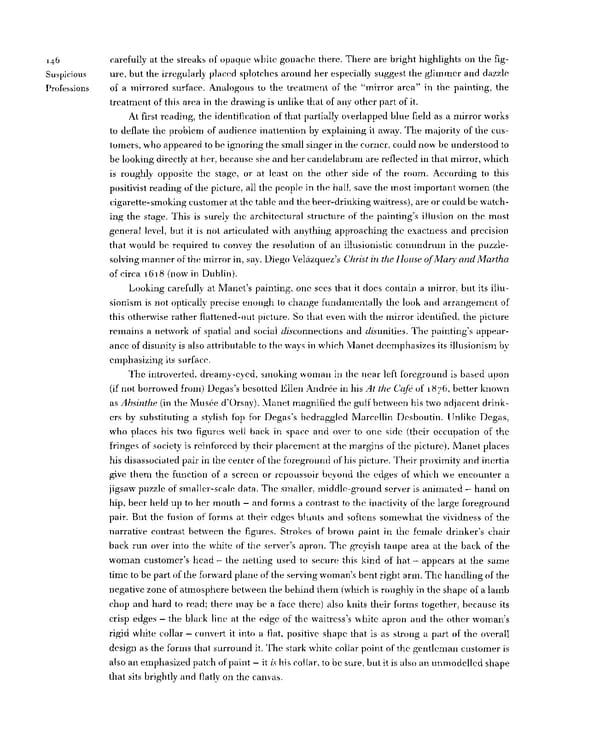146 carefully at the streaks of opaque white gouache there. There are bright highlights on the fig- Suspicious ure, but the irregularly placed splotches around her especially suggest the glimmer and dazzle Professions of a mirrored surface. Analogous to the treatment of the "mirror area" in the painting, the treatment of this area in the drawing is unlike that of any other part of it. At first reading, the identification of that partially overlapped blue field as a mirror works to deflate the problem of audience inattention by explaining it away. The majority of the cus- tomers, who appeared to be ignoring the small singer in the corner, could now be understood to be looking directly at her, because she and her candelabrum are reflected in that mirror, which is roughly opposite the stage, or at least on the other side of the room. According to this positivist reading of the picture, all the people in the hall, save the most important women (the cigarette-smoking customer at the table and the beer-drinking waitress), are or could be watch- ing the stage. This is surely the architectural structure of the painting's illusion on the most general level, but it is not articulated with anything approaching the exactness and precision that would be required to convey the resolution of an illusionistic conundrum in the puzzle- solving manner of the mirror in, say, Diego Velazquez's Christ in the House of Mary and Martha of circa 1618 (now in Dublin). Looking carefully at Manet's painting, one sees that it does contain a mirror, but its illu- sionism is not optically precise enough to change fundamentally the look and arrangement of this otherwise rather flattened-out picture. So that even with the mirror identified, the picture remains a network of spatial and social disconnections and ^unities. The painting's appear- ance of disunity is also attributable to the ways in which Manet deemphasizes its illusionism by emphasizing its surface. The introverted, dreamy-eyed, smoking woman in the near left foreground is based upon (if not borrowed from) Degas's besotted Ellen Andree in his At the Cafe of 1876, better known as Absinthe (in the Musee d'Orsay). Manet magnified the gulf between his two adjacent drink- ers by substituting a stylish fop for Degas's bedraggled Marcellin Desboutin. Unlike Degas, who places his two figures well back in space and over to one side (their occupation of the fringes of society is reinforced by their placement at the margins of the picture), Manet places his disassociated pair in the center of the foreground of his picture. Their proximity and inertia give them the function of a screen or repoussoir beyond the edges of which we encounter a jigsaw puzzle of smaller-scale data. The smaller, middle-ground server is animated — hand on hip, beer held up to her mouth — and forms a contrast to the inactivity of the large foreground pair. But the fusion of forms at their edges blunts and softens somewhat the vividness of the narrative contrast between the figures. Strokes of brown paint in the female drinker's chair back run over into the white of the server's apron. The greyish taupe area at the back of the woman customer's head - the netting used to secure this kind of hat - appears at the same time to be part of the forward plane of the serving woman's bent right arm. The handling of the negative zone of atmosphere between the behind them (which is roughly in the shape of a lamb chop and hard to read; there may be a face there) also knits their forms together, because its crisp edges — the black line at the edge of the waitress's white apron and the other woman's rigid white collar - convert it into a flat, positive shape that is as strong a part of the overall design as the forms that surround it. The stark white collar point of the gentleman customer is also an emphasized patch of paint - it is his collar, to be sure, but it is also an unmodelled shape that sits brightly and flatly on the canvas.
 Prostitution & Impressionists Page 166 Page 168
Prostitution & Impressionists Page 166 Page 168